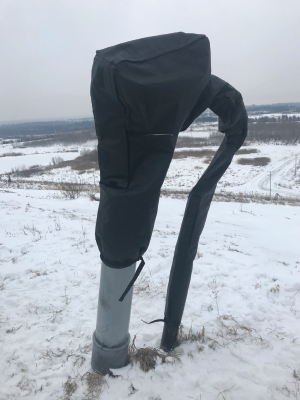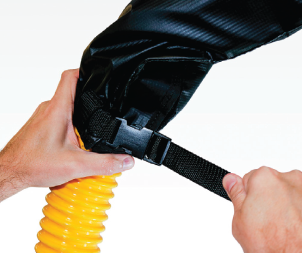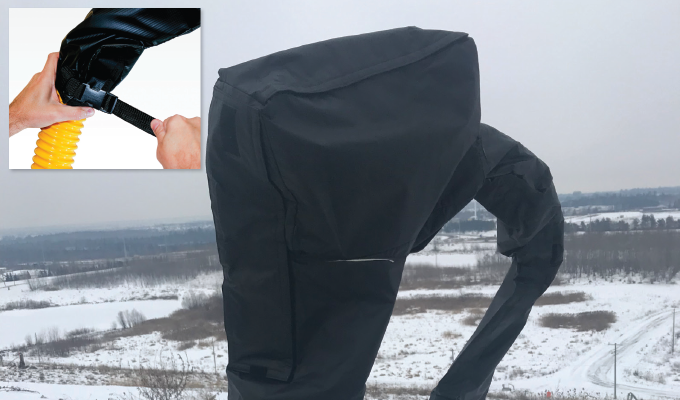By Eric Nielson and Valerie Nielsen, Q.E.D. Environmental Systems
When the temperatures at a landfill drop well below freezing levels, frozen condensation on wellheads and gas collection hoses can wreak havoc. Sub-zero temperatures and heavy winds can lead to freezing condensation in wellheads and landfill gas hoses, affecting gas extraction levels and causing unnecessary delays and expense. Landfill operators have a variety of options for protecting wellheads, including simple HVAC pipe insulation, heat tracing lines, chambers, and vaults. Now a new technology is available, a relatively low-cost insulating cover that protects the wells and keeps them aboveground, easy to access, and available all year round for easy maintenance.

FROZEN CONDENSATION RESTRICTS GAS FLOW AND MAY LEAD TO FALSE READINGS
Winter weather can cause many problems for landfill operators and landfill gas technicians. Often gas flow from the well is restricted. Then, if temperatures drop even lower, gas flow can be totally cut off and gas may be emitted to the atmosphere. Under the positive pressures that may occur with these conditions, the well cap can pop off, or the well can even pull apart, causing an air leak when temperatures rise.
Condensate blocking the gas wellhead may also lead to false and inaccurate gas level readings, which makes it more difficult for gas technicians to balance well fields to optimize gas collection. Freezing wellheads can also result in regulatory issues if gas is emitted, especially for United States landfills subject to Municipal Solid Waste Landfills: New Source Performance Standards (NSPS) requirements.
To protect wells from frozen condensation, many operators are up-sizing their wells to accommodate possible freezing. For example, an operator may select a 3-inch wellhead when there is not enough flow to merit that size. Wellheads should always be sized for the specific gas flow range conditions; up-sizing to provide more space results in a loss of accuracy in gas analyzer readings. When taking readings, most gas analyzers are looking to read a specific differential pressure range, usually between 0.5 inches and 5 inches. If a wrongly-sized wellhead is used, it will be difficult to get the differential pressure to fall in the proper range. Operators up-sizing wellheads to prevent freezing may end up spending double on the wellhead—for a far less accurate result.
There are a variety of methods available for protecting landfill gas wells from the effects of freezing conditions. Options range from simple low-tech solutions to expensive options that may not be in the budget of most sites.
RANGE OF AVAILABLE METHODS FOR PROTECTING WELLHEADS AND GAS COLLECTION HOSES
HVAC Insulation Sleeve
Landfill technicians are a hardy and resourceful lot. Over the years they have offered several creative solutions; while not perfect, they have gotten the job done. One example is a temporary, one-time use solution that involves wrapping an HVAC insulation sleeve (the type usually used to wrap pipes) around the wellhead and the gas hose. While the material cost is a fraction of that of other options, the sleeve must be replaced every winter and comes with a high labor cost. Also, the insulated sleeve does not prevent freezing. It simply gives operators a few more degrees before freezing occurs.
Electrically Powered Heat Tracing Lines
Some sites may employ electrically powered heat tracing lines to attempt to keep their wellheads and gas lines from freezing. This is only possible at sites where electricity is readily available at the wellhead location. Also, it is far from a perfect solution, since one must also place a piece of insulation around the line; the heat tracing alone will not be enough to keep the well from freezing.
Aboveground Chambers
Building a chamber encases the wellhead in an aboveground building or structure to keep it warm. Chambers are costly and they also present safety issues; technicians must follow proper confined space methods when opening the chamber and entering it to work on a gas wellhead. In addition, a chamber is not mobile, so it cannot be moved to another wellhead.
The chamber approach was used to great artistic effect at Montréal’s Parc Frédéric-Back, which is installing biogas capture spheres on 255 landfill biogas capture wells that sit on top of the 72-hectare former landfill. Victoria Taylor, in a report commissioned by the Ontario Association of Landscape Architects, notes, “By day, the spheres read like a pop-up field of white bubbles that appear to have just emerged from the gaseous depths below. By night, a self-illuminated lighting scheme uses a special surface paint made of phosphorescent fibers to store solar energy that is released as light.”
Underground Vaults
This is the highest cost option—at $50,000 to $100,000 apiece, vaults for a well field could easily cost hundreds of thousands of dollars. While commonly used, one disadvantage is that vaults are considered confined spaces, so safety for maintenance is a real concern.

NEW TECHNOLOGY ENTERS THE (FROZEN) FIELD
A new technology now available is QED’s PolarGuard Insulating Wellhead Cover, designed to be placed on and off wellheads easily using Velcro® closures and web buckle straps. The cover was developed based on requests and feedback from customers. Convinced that there was a real need in colder climate areas for something to prevent freezing of wellheads, QED engineers began researching possible solutions and came out with the PolarGuard design, which was recently released to the market.
A landfill in Ontario conducted a pilot demonstration of the covers last winter with excellent results. The site was on top of a steep hill that was pummeled by wind, with many very cold days perfect for testing out the new cover.
Says the gas technician, “We tried the PolarGuard wellhead insulator on one of our toughest wells in the field; one which had consistently been frozen solid every time we went to take readings. Since installing the PolarGuard, we haven’t had the wellhead freeze once and taking readings has been a breeze.”
Once installed, the cover can be left for the winter—or moved to another well. Depending on the site requirements and the value placed on the gas collected, operators may opt to purchase a few insulating covers and rotate them among their highest value wells or those that face the worst snow and wind conditions. They can then purchase additional covers when it fits in their expense budget.
COVERS PROMOTE EFFICIENCY AND EASE OF GAS REMOVAL
While many options exist, using the new PolarGuard covers is a low-cost way to guarantee accurate and efficient gas flow. The covers can be reused year after year and can serve as an insurance policy for high value wells in the most extreme environmental locations on sites where freezing problems may have occurred in the past.
FOR MORE INFORMATION
Q.E.D. Environmental Systems, a subsidiary of Graco Inc., is a leading manufacturer of innovative environmental pumping systems, landfill products, landfill gas products, and air strippers for use at landfills, mines, oil refineries, and other industrial sites, as well as hazardous waste cleanup sites. QED serves customers from support centers in Michigan and California. For more information, visit www.qedenv.com, call 734.995.2547, or email info@qedenv.com.
MODERN PUMPING TODAY, December 2020
Did you enjoy this article?
Subscribe to the FREE Digital Edition of Modern Pumping Today Magazine!



